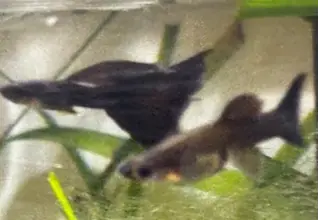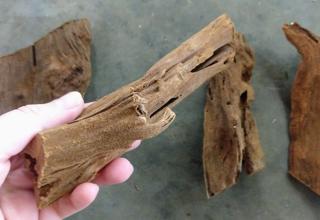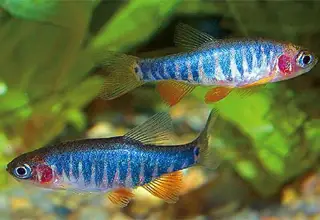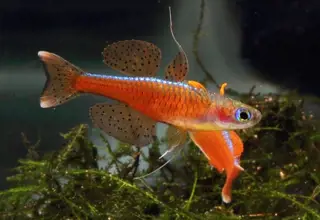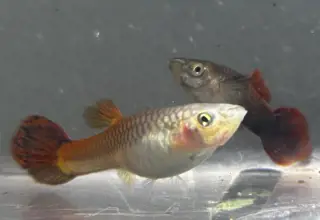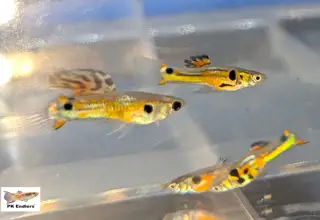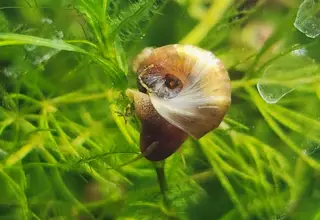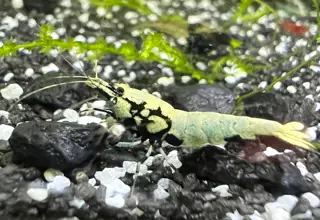Blue Diamond Discus Care: Diet, Lifespan, Diseases, Breeding & More
Posted by Miles Harrison on 10/18/2022
We use affiliate links and may receive a small commission on purchases.
Discus fish are some of the most sought-after fish in the freshwater aquarium hobby. Considered by many to be the crown jewel of freshwater fish, Discus have been bred to produce an incredibly wide variety of colors and patterns.
One of these color variations, the Blue Diamond, is a favorite among hobbyists, and it’s easy to understand why. With color typically only seen in reef fish, the Blue Diamond Discus might be the perfect species for your aquarium.
In this care guide, we’ll go over all there is to know about caring for this species. We’ll discuss some of the most common diseases, appearance, diet, and even breeding.
Species Summary
Known for its stunning colors and diamond-like sparkle, the Blue Diamond Discus (Symphysodon) is a variation of a species that hobbyists adore.
First bred successfully in the U.K. in 1956, Discus fish quickly captured the interests of hobbyists and the scientific community. Their unique appearance earned them the nickname “Flying Saucer Fish”, a fitting name for the fish’s round and slender body.
Discus were first classified in 1840 by scientist J.J. Heckel, but the Discus fish you might see today look significantly different from the first species documented in the 1800s. American breeders such as Jack Wattley and Mack Galbreath selectively bred the Discus species and were able to produce fish with a wide variety of color patterns.
One of these variations, known as the Blue Diamond, looks stunning in a freshwater aquarium. Whether you choose to keep a group of Blue Diamonds or pair a Blue Diamond up with other Discus variations, it will quickly become your new favorite freshwater species.
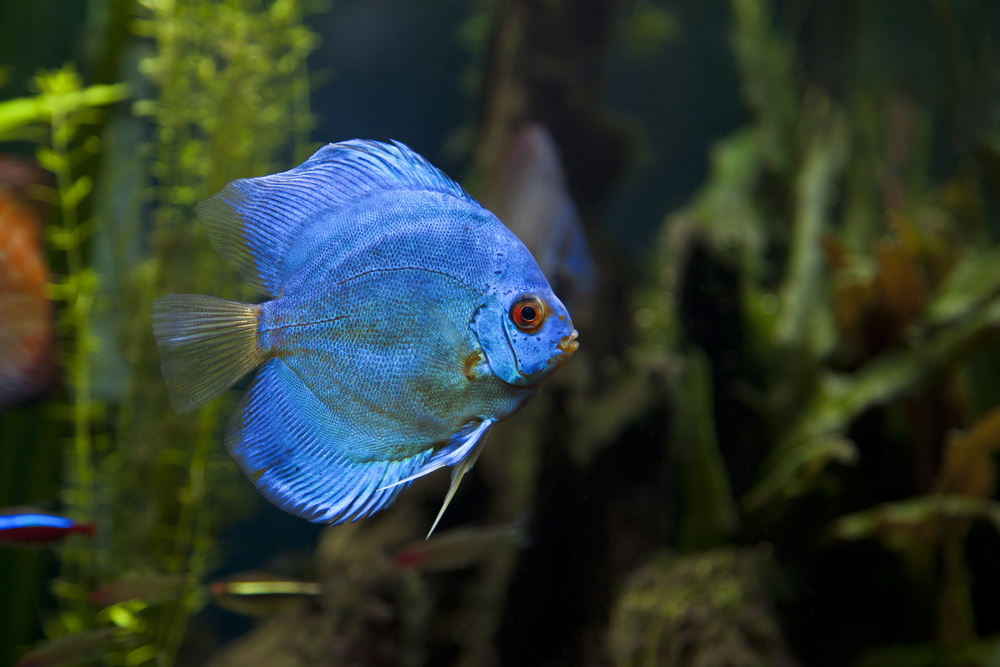
Appearance
The Blue Diamond Discus is a very flat fish. Its round body looks just like a silver dollar pancake! Their compressed appearance is what makes them so unique. Males are always larger than females, and when these fish are ready to breed, their fins and bodies will darken in color.
You can tell a Blue Diamond apart from other Discus variations, by its metallic-blue body. Blue Diamonds should appear completely blue, although some fish will show a bit of orange around their eyes and towards the end of their tail and dorsal fins.
Healthy Blue Diamonds should produce a subtle shimmer, and when exposed under high lighting, should become quite vibrant. Their pectoral and tail fins should be a shade of translucent blue, and their scales should be smooth to the touch.
These fish are a considerable size, and they have large fins to match. Their pelvic and dorsal fins are each about half the size of the fish's body.
Unhealthy fish will typically lose their vibrant coloration, and their blue color may start to turn into a dull gray. Coloration changes are usually seen first near the midsection of the fish, but can also occur in other parts of the fish’s body.
Black spots may also appear over time, this phenomenon called “peppering” is usually no cause for concern, as your discus is simply attempting to camouflage within its environment.
Size
Blue Diamond Discus are large fish. In the wild, they grow to be about 6 inches in length, but in an aquarium, they can grow to be even larger, and have been documented to reach 9 inches!
These fish are much larger than some of the more common nano schooling fish. If you’re looking to have your Discus grow to reach their full size, keeping them in a large aquarium is a must!
Blue Diamond Discus Care
Caring for a Blue Diamond Discus is no easy task, many aquarists consider Discus fish as some of the hardest to care for in the freshwater hobby.
Ancestors of Blue Diamond Discus are native to the Amazon river basin in South America. You’re going to want to recreate these conditions if you want to succeed in keeping this species.
Although it may seem difficult to recreate these tropical conditions at home, don’t let it discourage you! Aquarists and the scientific community have been keeping Discus at home for decades, and in today's information age, there is no better time than now.
Lifespan
Blue Diamond Discus can live long lives in a home aquarium. On average, these fish can live for ten years, but some aquarists have kept these fish for up to fifteen years!
As with all aquarium fish, life expectancy is usually directly correlated with quality of care and diet. Feeding your Blue Diamond a nutrient-rich diet, providing optimal water chemistry, and ensuring that they live a stress-free life will bring you success with this species.
Tank Size
If you’ve seen a Blue Diamond Discus in person, chances are you were pretty shocked by its size. It comes as no surprise that a fish as large as a Blue Diamond, or any Discus for that matter, requires a large aquarium. At a minimum, you should have an aquarium that’s at least 55 gallons if you plan on keeping a Blue Diamond Discus fish. But the bigger, the better. Many aquarists opt to keep these fish in aquariums over 100 gallons in size! Having a large aquarium gives you more flexibility with stocking options, and can give you a better chance of maintaining good water quality.
Water quality and tank mates aren’t the only reason why you need a large aquarium to house a Blue Diamond Discus. These fish also love to swim! You might spot these fish hovering in place in the open areas of a tank and think they are resting, but don’t look away for too long! These fish will dart back and forth from one side of a tank to the other as they investigate the aquarium for new potential food sources. When kept in a group, they like to stick together, and even tend to exhibit playful behavior amongst one another.
Water Conditions
If you’re looking to give your Blue Diamond Discus the best life possible, you’ll need to recreate the water chemistry found in their natural environment.
Discus fish hail from the Amazon River Basin, where water temperatures are warm and water is slightly acidic. They live in blackwater rivers, made up of decaying vegetation and plant matter.
These waters tend to have fewer minerals compared to freshwater lakes, so it comes as no surprise that the Blue Diamond Discus will prefer water on the acidic side.
If you can manage to maintain the following water conditions, you should be in excellent shape.
Temperatures: 79°F-86°F
KH: 3-8 DKH
pH: 6.1-7.5
One of the most important steps in Discus keeping is maintaining water chemistry levels over a sustained period of time. Sudden, drastic changes in water chemistry can prove fatal to sensitive species such as Discus.
Tank Setup
Now that you’re familiar with the water chemistry levels, let’s discuss tank setup. Starting at the bottom of the tank, you’ll want to choose the right substrate. The best substrate for discus is without a doubt Pool Filter Sand .
Pool Filter Sand is all-white in color, which will prevent your fish from experiencing peppering. Peppering occurs when Discus fish attempt to camouflage. Darker substrates, such as CaribSea’s eco-complete can increase the chances that the black “pepper” dots will start to appear over the body of your Discus fish.
The Blue Diamond Discus will appreciate having lots of available plants, some of our favorite Discus-friendly plants include Taiwan Lilies and Hygrophila Salicifolia. Since Discus fish need plenty of room to swim, make sure that your plants don’t take over an aquarium. If you have fast-growing plants, be sure to frequently trim and prune, so that your tank doesn’t become overcrowded.
When it comes to hardscape, most rocks and stones or aquarium driftwood will be appreciated by Discus fish. It’s always fun to spot a Blue Diamond swimming through a man-made cave in an aquarium.
You’ll also want to provide an adequate filter, we recommend a large canister filter that’s rated for your aquarium, from a trusted brand such as Eheim for your Discus tank.
Since Discus are native to slow-moving bodies of water, you won’t need extra circulation, so you can skip adding any additional Powerheads. However, you’ll want to make sure temperatures consistently stay on the warmer side. A good aquarium heater suited for your tank should do the trick. You can also purchase an aquarium thermometer to monitor the temperature.
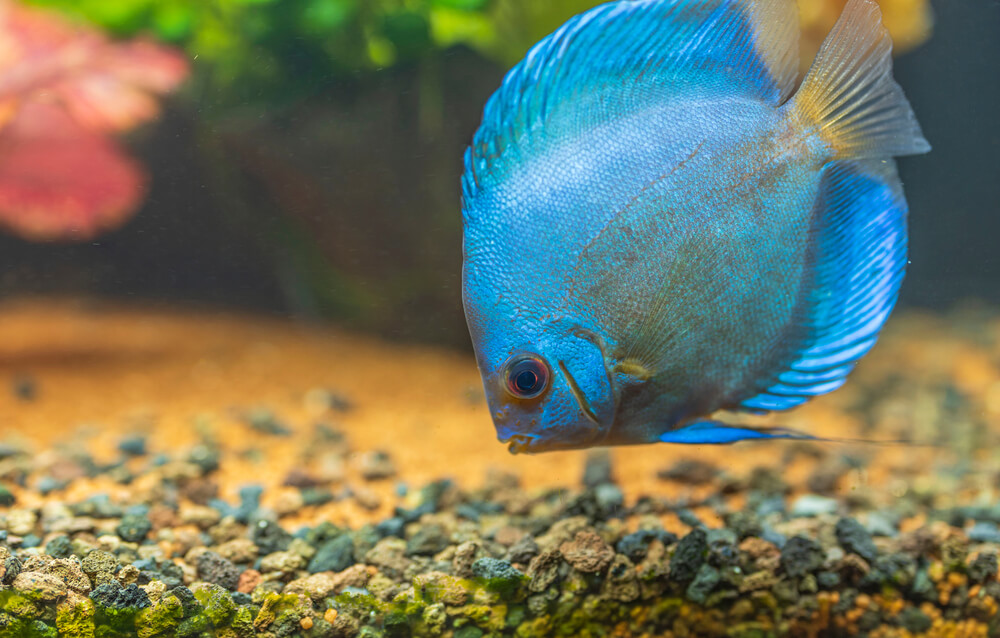
Common Diseases
Like all fish, Discus fish are susceptible to all sorts of diseases and parasites in a home aquarium. The Blue Diamond Discus is no different, and you’ll want to watch out for some of the more common ailments.
One of the most common bacterial infections is called fin rot. Fin rot, as you may have guessed, affects the fins of Discus fish. If you notice your Discus’s fins starting to look as if they’re melting away, or appearing tattered, most likely they are experiencing this infection.
Typically, the number one cause of fin rot is poor water quality. Purchasing a reliable water testing kit is one of the best purchases you can make as a Discus owner. Monitoring ammonia and nitrite levels to be sure that they never exceed 0ppm is a surefire way to prevent this bacterial infection from taking hold.
Another health issue to look out for, are internal parasites. When discus fish become stressed, they are susceptible to internal parasites. One of the first signs you’ll notice with internal parasites is white excrement appearing along the substrate. You can treat internal parasites with a liquid solution such as Hikari’s Prazi-pro .
However, the best type of treatment is prevention! Always consistently test your water, and inspect any new inhabitants you plan on introducing into your aquarium for parasites or other illnesses. Overfeeding, and forgetting to perform bi-weekly 40% water changes are the most common causes of poor water quality, so make sure you’re staying on top of your water parameters!
Lighting
Discus fish aren’t very picky when it comes to lighting, after all, they are native to the Amazon basin, where shade and foliage are abundant. But a Blue Diamond Discus looks quite different from its amazon-dwelling relatives. You’re going to want to show off the colors of this fish in a home aquarium, and providing some bright lighting will make this fish truly dazzle.
We recommend an aquarium light that is at least 2-3 watts per gallon when keeping a Blue Diamond Discus.
Combined with a high-quality diet, powerful lighting can bring out the best colors of a Blue Diamond Discus. But be warned, intense lighting can quickly produce a ton of algae. If you notice algae growing on leaves make sure you have a plan in place for removal.
Food & Diet
Discus fish are a sensitive species, but luckily for aquarists, their dietary needs are similar to most other freshwater aquarium fish species.
In the Amazon, Discus fish can be found feeding on worms, small invertebrates, decaying plant matter, and other forms of algae. In an aquarium, adult Blue Diamond Discus fish will benefit from high-quality flake food, sinking shrimp pellets, and nutrient-rich spirulina flakes.
You’ll want to feed your Blue Diamond Discus fish at least once a day, but twice-a-day feedings are preferred. Feed your Discus fish just enough food that they can consume in 2 minutes. As an occasional treat, you can give your Discus fish frozen or thawed bloodworms, but feed these sparingly, as they contain little nutritional benefit.
Behavior and Temperament
The Blue Diamond Discus fish is a peaceful fish, but don’t be surprised if you notice some signs of aggression when first introducing one into an aquarium. Discus fish will chase each other and occasionally nip at the tails of other fish until a dominance hierarchy is established.
You might also see small signs of aggression when your Blue Diamond is getting ready to breed. Discus will try and outcompete one another when looking for a breeding partner to pair up with, so ensure your aquarium has plenty of open space so that your fish can claim their territories, and escape if being chased.
In general though, once established, Discus fish won’t give you an issue when it comes to their personality. They can co-exist with most other peaceful species, including small schooling fish.
If you notice your Blue Diamond Discus showing signs of aggression, ensure that they have plenty of space to swim, and are being fed a sufficient diet. A hungry fish is an unhappy fish, and providing them with enough food should always be a top priority.
Tank Mates
Aquarists interested in keeping the Blue Diamond Discus will be happy to know that they’re compatible with a large number of peaceful freshwater fish species.
You can create some dramatic aquascapes by hosting a small school of Blue Diamonds, but if you want some more variety, you can keep Blue Diamonds with virtually any other type of Discus.
As long as your aquarium is large enough, you should have no problem keeping your Discus with other types of fish. Even smaller fish can coexist with Blue Diamonds.
Some of our favorite tank mates include:
- Clown Loaches
- Koi Angelfish
- Orange Pumpkin Shrimp
- Cardinal Tetras
- Neon Tetras
- Purple Moscow Guppies
- White Cloud Minnows
- Harlequin Rasboras
- Celestial Pearl Danios
- Assassin Snails
Avoid pairing Blue Diamond Discus with more aggressive species, such as the Galaxy Koi Betta or Electric Blue Jack Dempsey.
Breeding
Discus breeding is no easy feat, and breeding Blue Diamond Discus comes with its unique challenges. However, if you are fortunate enough to have a male/female pair of Blue Diamond Discus, it’s possible to breed this species at home.
You can encourage breeding by increasing the temperature in your aquarium. Aim for 80°F-86°F. If you notice your Discus fish starting to pair off, you can move them into a separate breeding tank.
You’ll need to keep the temperatures warm in the breeding tank, and water conditions must be immaculate. You’ll want the breeding tank to be fully established before you move your Discus fish into this tank. Add plenty of plants for the Discus to lay their eggs on, or you can also purchase a breeding cone . If you’re lucky, your female will lay eggs which will then be fertilized by the male. After a few weeks, the eggs should hatch into fry.
Discus fry will feed on the mucous present on their parents' skin, but you’ll also want to feed them daily pieces of broken-up brine shrimp 4 times a day. Raising the Discus fry is the most difficult part of breeding. You’ll want to perform daily 50% water changes to prevent an imbalance in water chemistry. Over the next few weeks, you can continue to feed the fry more protein-enriched foods, such as flake food or spirulina.
Raising the fry can be incredibly challenging, so don’t get discouraged if you don’t succeed on your first attempt! If you can manage to raise your fry until they grow to be about the size of a half-dollar coin, you can pat yourself on the back, as you’ve successfully bred Blue Diamond Discus.
In Conclusion
As you can see, there are plenty of advantages to owning a Blue Diamond Discus. Not only is this species one of the most vibrant color variations of Discus fish available, but it can also be an incredibly rewarding experience just to care for this species.
Owning and providing for Discus is no easy feat. Keeping a healthy Blue Diamond Discus is a true testament to your skill as a freshwater aquarium hobbyist. If you’re new to the hobby, you may want to stay clear of this species, but if you’re up for the challenge, we guarantee you’ll love what these fish have to offer.
As always, if you have any questions, comments, or feedback, we’d love to hear from you. Consider introducing yourself over on our community forum, where other hobbyists share photos of their tanks and discuss fishkeeping. Thanks for reading!
December's Giveaways on Light Fish
